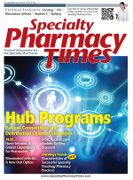Publication
Article
Specialty Pharmacy Times
Hub Programs Continue to Add Value as They Evolve
Author(s):
Today's hub programs are "patient solution centers," connecting patients with all the health care professionals who are involved in their care. The utilization of hubs is integral to the future of specialty products.
Today’s hub programs are “patient solution centers,” connecting patients with all the health care professionals who are involved in their care. The utilization of hubs is integral to the future of specialty products.
We have all read the headlines on the rising cost of health care and the increasing visibility specialty products have in the market. With monthly cost of therapy exceeding $2500, there is a critical need to identify and navigate the appropriate path for reimbursement of a particular product for a specific patient.
To begin the process, the correct benefit has to be established, whether under a medical benefit or through the pharmacy benefit. In addition, there are various prior authorization and appeals processes within the payers that must be managed, all while supporting a relatively small target patient population. For the past couple of decades, specialty products have presented challenges in the market. When the need to support Risk Evaluation and Mitigation Strategies (REMS) requirements is introduced into the equation—in addition to the increasing complexity on the payer side of the table— the situation becomes even more difficult.
In an effort to provide a solution to alleviate these barriers to product access, manufacturers developed product support programs and reimbursement hotlines to support patients and health care practitioners. The programs began to hit the marketplace as a tool to support the commercial success of specialty products in the mid-1990s. Today, as these risks continue to exist in the marketplace, the level of treatment complexity, need to differentiate between products, and continual cost pressures have kept patient support programs front and center.
Through this evolution came the ability to tailor these programs to address the variations found within patient populations, payer challenges, and distribution channel strategies. What started off as a simple call center approach with a need to provide straightforward information on the reimbursement profile of a product matured into an opportunity to create product differentiation, impact speed to therapy, and improve patient outcomes through retention on therapy. The key to success is to understand all the potential levers available to support a product both today and into the future. Let’s examine some of these levers.
PATIENT NEEDS
Connectivity with patients is the most important aspect of a Hub program today. Previously, the focus within these programs was the tactical execution of reimbursement services. Simply providing this solution is not enough in today’s world. The hub programs of today are actually “Patient Solution Centers” and must connect the patients and practitioners to the brand.
As the name implies, the goal of these solution centers is to be patient-centric “flight operations,” if you will, for all the various support elements required to both move a patient onto therapy and keep the patient engaged with their treatment. Through an understanding of patient demographics and behaviors as revealed through market research, a program design is put in place establishing the appropriate conduits of communication with a program. Leveraging today’s various technology tools—as basic as a web portal to integrating social networking—allows patients to interact through their medium of choice. While the most common communication channel continues to be the telephone, the ability to present additional avenues such as web chat or texting in a secure manner drives differentiation in the marketplace.
Due to the increased level of support provided directly to patients through specialty pharmacies, hub program designs have evolved. Where these programs used to automatically provide full reimbursement support for patients, they are now more frequently utilized to ensure a patient is transitioned to the pharmacy that can move the patient onto commercial therapy as quickly as possible. The interactions between the hub and the network pharmacies have become an integral program component.
DISTRIBUTION CHANNELS
When establishing a hub program design, the distribution channel strategy is as important as the patient connection. Keeping in mind the typical profile of a specialty product—expensive, smaller number of patients, and often cold chain— channel strategy provides an opportunity for manufacturers to have a significant impact on the patient experience with their product. Removing the need for open distribution, the next decision point faced by a manufacturer has been how much to limit access through the number of participating pharmacies. Increased control is obtained by tightly constricting the number of distribution points.
For orphan disease states or products with a stringent REMS program, it is not unusual to see single or extremely limited points of distribution for all patients. For the manufacturers, the top consideration when evaluating the number of specialty pharmacy partners is to obtain access to the maximum number of “covered lives” while also maintaining the greatest amount of control over the channel. It is by connecting the patient-focused solution center with the appropriate number of channel partners with data integration that these programs bring forth value, whether it is in moving patients onto paid therapy through the use of 501(c)3 foundation funding or simply making certain that participating network pharmacies are driving compliance and adherence.
In addition to considering the appropriate specialty pharmacy channel, manufacturers are considering opportunities to shorten the supply chain. Strategies in the market today include using a third-party logistics organization, connected directly to the hub provider, to manage inventory movement to the network of pharmacies. Closely related to this approach is the ability of a manufacturer to sell product through a partner pharmacy “directly” to patients. While not a fit for all products, this avenue allows the manufacturer to maintain direct control over a portion of the supply chain. It is through the mixing and matching of the various channel management strategies that product differentiation can be achieved.
PARTNERSHIP FOR SUCCESS
Historically, hub programs were administered by organizations that did not have a dispensing operation—a pharmacy. It was thought that this created a neutral, holistic approach to the management of the program. While this approach to selecting a partner organization for hub services remains true for brands that face stiff competition, another key consideration must be their hands-on patient management experience. For this reason, the industry has seen growth in the number of specialty pharmacies managing hub programs.
In the eyes of the manufacturer, the most important goal is to move patients onto clinically appropriate commercial therapy as quickly as possible. The second goal is to keep patients engaged with and on their therapy as indicated. Hub programs have always been a tool through which these goals have been achieved. When evaluating potential participants in these programs, manufacturers are now more than ever looking at not only people, processes, and experience, but also the total number of “tools” in the tool box prior to selecting a partner.
While a product may launch today with a single niche indication, the hub program should be designed to support growth in the number of indications as well as number of patients. Whether the program starts as an exclusive Central Service Provider model, with tight integration between the reimbursement support operations and product dispensing, or is more of a hub solution center, the ability to adapt rapidly to an ever-changing marketplace is imperative.
As the specialty marketplace continues to grow and a focus on the costs associated with these products increases, the utilization of hub programs will play an integral role in the future of specialty products.
About the Author
David Hileman, RPh, was named senior vice president of operations for the Specialty Care Group in June 2012. His responsibilities include operational and business development leadership for the group. Prior to this role, David provided daily leadership for the operational integration of the newly formed Specialty Care Group. He was part of the executive launch team at RxCrossroads, which developed a wholesale and distribution operation into one of the nation’s best-regarded and fastest-growing specialty pharmaceutical services companies. David has broad operations and business development experience in the pharmaceutical and biotechnology industries with a focus on solutions supporting specialty products and chronic complex disease states across the product supply cycle from manufacturer to patient. His experience spans retail and specialty pharmacy, as well as wholesale distribution and thirdparty logistics. David is a registered pharmacist and earned a bachelor of science in pharmacy and a bachelor of science in business administration from Ohio Northern University. To contact David directly, call (502) 213-1104 or email david. [email protected].







